| Funding: | German Federal Ministry for Economics Affairs and Energy (BMWi) |
| Partners: | WindMW Service GmbH |
| Duration: | 10/2016 – 09/2020 |
Within the scope of this project, local wind measurements are taken at up to great heights at offshore locations using the cost-effective floating LiDAR technology. In addition, a method is also being developed to determine turbulence, as an important parameter for the load analysis, based on the measurement data obtained from the floating LiDAR system
To achieve these goals, a measurement campaign will be conducted at the wind farm “Meerwind Süd|Ost” planned by the project partner WindMW. To this end, the floating LiDAR system, which was developed at Fraunhofer IWES, will be deployed to enable the wind conditions at one site to be determined flexibly. The LiDAR technology allows wind data, which are required to examine wind shear for large rotors, to be measured at up to great heights.
The measurement data are used to create the design basis for the turbine and supporting structure, which, in turn, forms the basis for the load calculation. The influence of ambient data on the load situation of the supporting structure and the wind turbine is calculated by contrasting the loads used for the expanded design basis with the results of a conventional load calculation. The primary goal of this undertaking is to reduce offshore wind energy generation costs even further.
